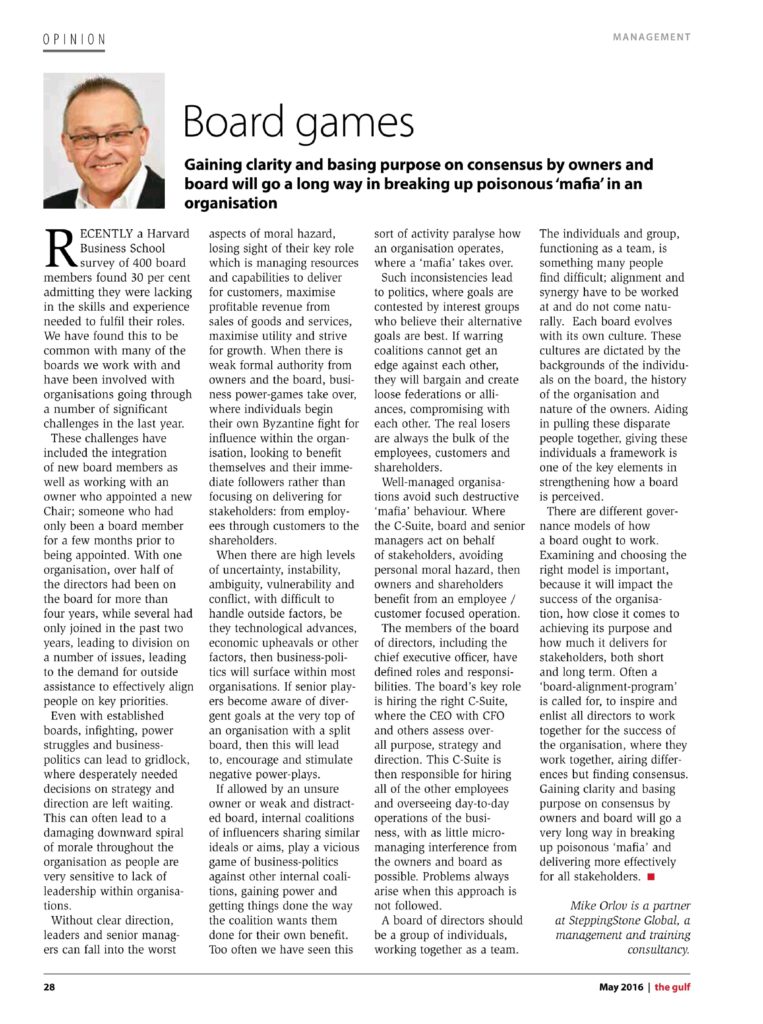
Effective Board Members
Recently a Harvard Business School survey of 400 board members found 30 per cent admitting they were lacking in the skills and experience needed to fulfil their roles. We have found this to be common with many of the boards we work with and have been involved with organizations going through a number of significant challenges in the last year.
These challenges have included the integration of new board members as well as working with an owner who appointed a new Chair; someone who had only been a board member for a few months prior to being appointed. With one organization, over half of the directors had been on the board for more than four years, while several had only joined in the past two years, leading to division on a number of issues, leading to the demand for outside assistance to effectively align people on key priorities.
Even with established boards, infighting, power struggles and business-politics can lead to gridlock, where desperately needed decisions on strategy and direction are left waiting. This can often lead to a damaging downward spiral of morale throughout the organization as people are very sensitive to lack of leadership within organizations.
Without clear direction, leaders and senior managers can fall into the worst aspects of moral hazard, losing sight of their key role which is managing resources and capabilities to deliver for customers, maximize profitable revenue from sales of goods and services, maximize utility and strive for growth. When there is weak formal authority from owners and the board, business power-games take over, where influencers begin their own Byzantine fight for influence within the organization, looking to benefit themselves and their immediate followers rather than focusing on delivering for stakeholders: from employees through customers to the shareholders.
When there are high levels of uncertainty, instability, ambiguity, vulnerability and conflict, with difficult to handle outside influences, be they technological advances, economic upheavals or other difficult to handle factors, then business-politics will surface within most organizations. If senior players become aware of divergent goals at the very top of an organization with a split board, then this will lead to, encourage and stimulate negative power-plays.
If allowed by an unsure owner or weak and distracted board, internal coalitions of influencers sharing similar ideals or aims, play a vicious game of business-politics against other internal coalitions, gaining power and getting things done the way the coalition wants them done for their own benefit. Too often we have seen this sort of activity paralyse how an organization operates, where a ‘mafia’ takes over.
Such inconsistencies lead to politics, where goals are contested by interest groups who believe their alternative goals are best. If warring coalitions cannot get an edge against each other, they will bargain and create loose federations or alliances, compromising with each other. The real losers are always the bulk of the employees, customers and shareholders.
Well-managed organizations avoid such destructive ‘mafia’ behaviour. Where the C-Suite, board and senior managers act on behalf of stakeholders, avoiding personal moral hazard, then owners and shareholders benefit from an employee / customer focused operation.
The members of the board of directors, including the chief executive officer, have defined roles and responsibilities. The board’s key role is hiring the right C-Suite, where the CEO with CFO and others assess overall purpose, strategy and direction. This C-Suite is then responsible for hiring all of the other employees and overseeing day-to-day operations of the business, with as little micro-managing interference from the owners and board as possible. Problems always arise when this approach is not followed.
A board of directors should be a group of individuals, working together as a team. The individuals and group, functioning as a team, is something many people find difficult; alignment and synergy have to be worked at and do not come naturally. Each board evolves with its own culture. These cultures are dictated by the backgrounds of the individuals on the board, the history of the organization and nature of the owners. Aiding in pulling these disparate people together, giving these individuals a framework is one of the key elements in strengthening how a board is perceived.
There are different governance models of how a board ought to work. Examining and choosing the right model is important, because it will impact the success of the organization, how close it comes to achieving its purpose and how much it delivers for stakeholders, both short and long term. Often a ‘board-alignment-program’ is called for, to inspire and enlist all directors to work together for the success of the organization, where they work together, airing differences but finding consensus. Gaining clarity and basing purpose on consensus by owners and board will go a very long way in breaking up poisonous ‘mafia’ and delivering more effectively for all stakeholders.
